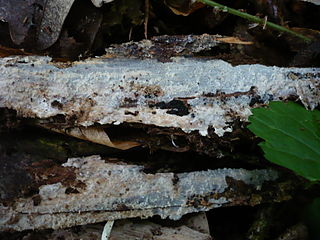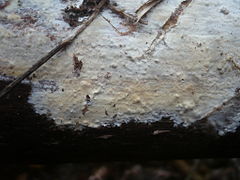
The Clavulinaceae are a family of fungi in the order Cantharellales. The family is not well defined, but currently comprises species of clavarioid fungi as well as some corticioid fungi. These species are nutritionally diverse, some being ectomycorrhizal, others wood-rotting saprotrophs, others lichenized, and yet others lichenicolous.

Phanerochaete is a genus of crust fungi in the family Phanerochaetaceae.

The Steccherinaceae are a family of about 200 species of fungi in the order Polyporales. It includes crust-like, toothed, and poroid species that cause a white rot in dead wood.

The Xenasmataceae are a family of crust fungi in the order Polyporales. The family was circumscribed in 1966 by German mycologist Franz Oberwinkler with Xenasma as the type genus. As of April 2018, Index Fungorum accepts 28 species in the family. Xenasmataceae fungi grow as saprobes on fallen wood and are known primarily from temperate areas.

The Botryobasidiaceae are a family of fungi in the order Cantharellales. The family contains a group of corticioid fungi that form thin, web-like basidiocarps. Some species form asexual anamorphs producing chlamydospores. All are believed to be wood-rotting or litter-rotting saprotrophs. None is known to be of any economic importance.
Laurilia is a monotypic genus of crust fungi in the family Echinodontiaceae. The genus was described in 1959 by Czech mycologist Zdeněk Pouzar, with Laurilia sulcata as the type and only species. Pouzar then transferred Laurilia taxodii from Stereum to Laurilia in 1968, but Liu et al. erected the new genus Laurillela for the latter species in 2017 on the basis of ribosomal DNA molecular phylogeny. Liu et al. also found the Echinodontiaceae as traditionally circumscribed to be paraphyletic and placed Laurilia and Lauriliella instead in the Bondarzewiaceae, though this placement is not yet reflected in taxonomic authorities such as the Index Fungorum.

Byssomerulius is a widely distributed genus of crust fungi.

Resinicium is a genus of crust fungi of uncertain placement in the class Agaricomycetes. The genus was circumscribed by Estonian mycologist Erast Parmasto in 1968.

Phlebia is a genus of mostly crust fungi in the family Meruliaceae. The genus has a widespread distribution. Phlebia species cause white rot.
Gloeohypochnicium is a genus of wood-inhabiting crust fungi of uncertain familial placement in the order Russulales. Originally conceived by Erast Parmasto as a subgenus of Hypochnicium, Kurt Hjortstam considered it worthy of distinct generic status in 1987. The type species, G. analogum, was described as new to science in 1913 by French mycologists Hubert Bourdot and Amédée Galzin as a species of Gloeocystidium. G. versatum was added to the genus in 2010.

Hydnophlebia is a genus of five species of toothed crust fungi in the family Meruliaceae. All species are wood-decay fungi that cause a white rot.

Subulicystidium is a genus of corticioid fungi in the family Hydnodontaceae. The genus has a widespread distribution, and contains seven species.
Fibrodontia is a genus of fungi in the Hydnodontaceae family. The widely distributed genus was circumscribed by Erast Parmasto in 1968. According to Index Fungorum, the type species Fibrodontia gossypina is currently known as Hyphodontia gossypina (Parmasto) Hjortstam.
Athelopsis is a genus of corticioid fungi in the family Amylocorticiaceae. The widespread genus, estimated to contain 10 species, is polyphyletic as currently circumscribed.
Boreostereum is a genus of corticioid fungi. The genus was circumscribed in 1968 by Erast Parmasto to contain the type species, which was formerly known as Stereum radiatum. Boreostereum has four species that are widely distributed in northern temperate areas. Species in the genus have a dimitic hyphal system, and the hyphae have with brown encrustations that turn greenish when potassium hydroxide is applied. Boreosterum vibrans produces vibralactones, chemical metabolites that inhibit various enzymes. Recent phylogenetic research indicates that Boreostereum is a sister group to the rest of the Gloeophyllales.
Dichochaete is a genus of fungi in the family Hymenochaetaceae. The genus was circumscribed in 2000 by Estonia mycologist Erast Parmasto.

Liiva-Putla Nature Reserve is a nature reserve situated on Saaremaa island in western Estonia, in Saare County.

Fibroporia is a genus of ten species of poroid crust fungi in the family Fomitopsidaceae. The genus contains species similar to those in genus Antrodia, but they are phylogenetically distinct.
Lilaceophlebia is a genus of three species of crust fungi in the family Meruliaceae. The genus was first proposed by Erast Parmasto in 1968 as a section of the genus Phlebia. Viacheslav Spirin and Ivan Zmitrovich elevated the taxon to generic status in 2004.













